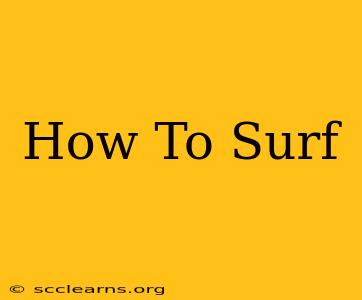So, you want to learn how to surf? That's awesome! Surfing is an incredible sport that combines athleticism, balance, and a deep connection with nature. While it might seem intimidating at first, with patience and practice, you can be catching waves and feeling the stoke in no time. This guide will walk you through the essentials of how to surf, from choosing the right equipment to mastering the pop-up.
Getting Started: Choosing Your Gear
Before you even hit the water, you need the right gear. This includes:
-
Surfboard: Beginners should start with a longboard. These boards are longer and wider, making them more stable and easier to paddle and catch waves. Avoid shortboards until you have a solid foundation. Consider renting a board initially to see if you enjoy surfing before investing in your own.
-
Leash: A leash connects your board to your ankle, preventing it from drifting away and keeping you safe. It's crucial for your safety and the safety of others in the water.
-
Wetsuit (if needed): Depending on the water temperature, a wetsuit will keep you warm and comfortable. Check local water temperatures before deciding whether you need one.
Finding the Perfect Wave: Location, Location, Location
Learning to surf requires the right environment. Look for:
-
Beginner-friendly breaks: These are typically waves that break gently and slowly, giving you ample time to paddle and stand up. Avoid powerful, fast-breaking waves as a beginner.
-
Sandy bottom: A sandy bottom is much more forgiving than a rocky bottom, preventing injuries if you wipe out.
-
Less crowded lineups: Learning in a crowded lineup can be overwhelming and dangerous. Look for spots with fewer surfers, especially when starting out.
Mastering the Basics: Paddling, Popping Up, and Riding
Now for the fun part – actually surfing! Here's a breakdown of the key techniques:
1. Paddling: The Powerhouse of Surfing
Efficient paddling is essential for catching waves. Lie flat on your board, using a strong, rhythmic motion to propel yourself forward. Keep your core engaged and your body streamlined to reduce drag. Practice paddling in calm water before attempting to catch waves.
2. Catching a Wave: Timing is Everything
Identify an incoming wave and start paddling furiously as it approaches. You'll feel the wave's power pushing you forward. Time your paddling so you're riding the wave's energy.
3. The Pop-Up: From Prone to Standing
This is the most challenging part for beginners. As you feel the wave's power, quickly push up to your feet. Many surfers find the following sequence helpful:
- Push up with your hands: Place your hands shoulder-width apart, just behind your chest.
- Bring your feet under you: Bring your feet under your chest, one at a time. Many find bringing their feet to the 'push-up' position the easiest to practice first.
- Stand tall and balanced: Keep your knees bent and your weight centered. Look in the direction you're riding.
Practice your pop-up on land or on a stable surface before attempting it in the water.
4. Riding the Wave: Balance and Control
Once you're up, maintain your balance by keeping your knees slightly bent and your weight centered. Use your feet to steer the board by shifting your weight. Enjoy the ride!
Essential Tips for Success:
- Take lessons: A qualified surf instructor can provide personalized guidance and significantly speed up your learning process.
- Practice consistently: The more time you spend in the water, the better you'll become.
- Be patient: Surfing takes time and dedication. Don't get discouraged if you don't catch waves or fall right away; this is part of the learning process.
- Respect the ocean: Always be aware of your surroundings and follow ocean safety guidelines.
Surfing is a rewarding and challenging sport. By following these steps and practicing regularly, you'll be catching waves and experiencing the thrill of riding the ocean in no time. Hang loose and have fun!

